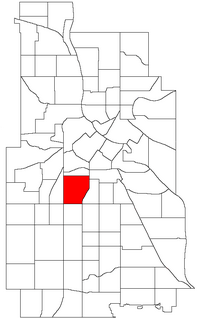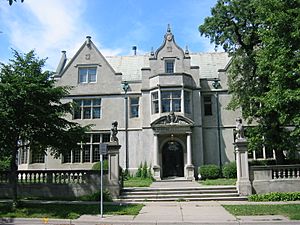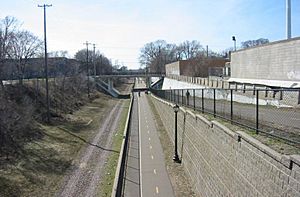Whittier, Minneapolis facts for kids
Quick facts for kids
Whittier
|
|
|---|---|
|
Neighborhood
|
|
| Nickname(s):
Eat Street
|
|
| Motto(s):
The International Neighborhood
|
|

Location of Whittier within the U.S. city of Minneapolis
|
|
| Country | United States |
| State | Minnesota |
| County | Hennepin |
| City | Minneapolis |
| Community | Powderhorn |
| Founded | 1849 |
| Established | 1977 |
| Founded by | John Blaisdell |
| Named for | John Greenleaf Whittier |
| City Council Ward | 10 |
| Area | |
| • Total | 0.816 sq mi (2.11 km2) |
| Elevation | 866 ft (264 m) |
| Population
(2020)
|
|
| • Total | 14,483 |
| • Density | 17,749/sq mi (6,853/km2) |
| Time zone | UTC-6 (CST) |
| • Summer (DST) | UTC-5 (CDT) |
| Postal code |
55404, 55405, 55408
|
| Area code(s) | 612 |
| Website | http://www.whittieralliance.org/ |
Whittier is a lively neighborhood in the city of Minneapolis, Minnesota. It's part of the Powderhorn community. The neighborhood is bordered by Franklin Avenue to the north, Interstate 35W to the east, Lake Street to the south, and Lyndale Avenue to the west.
Whittier is famous for its many different restaurants, coffee shops, and Asian markets. You'll find most of these along Nicollet Avenue, which is also known as "Eat Street". This area is also home to important places like the Minneapolis Institute of Art, the Minneapolis College of Art and Design, and the Children's Theatre Company.
Even though Whittier is officially part of the Powderhorn community, it's separated from most of it by Interstate 35W. It's also located further north. Whittier is often linked with nearby neighborhoods like Lowry Hill East and Stevens Square.
Contents
Exploring Whittier's Past
Early Days and Dakota People
In the 1800s, the Mdewakanton Dakota people lived in this area. They had moved from Mille Lacs Lake and settled near Saint Anthony Falls and the Minnesota River. Photos from the MNHS show temporary Dakota camps in what is now Whittier.
In 1849, a 21-year-old named John T. Blaisdell moved from Maine. He settled on land just south of downtown Minneapolis. His brothers joined him, and they lived in a log house. This house later became the Blaisdell School.
After the 1851 Treaty of Traverse des Sioux, which opened up lands for settlement, Blaisdell began developing the area. He sold timber to the growing lumber industry. He also leased land for the Morrison Farm, which the Morrison family eventually bought.
From Blaisdell to Whittier
After the Civil War ended in 1865, Minneapolis started growing fast. In 1867 and 1883, Blaisdell's Addition became part of South Minneapolis. Business people built large homes in the Washburn-Fair Oaks Mansion District. Much of the Morrison's farm was sold for this expansion. Fair Oaks Park was once the site of William D. Washburn's mansion.
Meanwhile, the southern part of Whittier grew as a place for farming and factory jobs. Working-class homes were built along the Milwaukee Road rail line. This line, along 29th Street, was used to ship grain. Blaisdell Road became Blaisdell Avenue, stretching beyond the neighborhood.
In 1882, Blaisdell built his own large house at Nicollet and 24th Street West. The family moved out of the old Blaisdell School. A year later, Blaisdell, Longfellow, and Irving Schools joined the Minneapolis school system. Following the tradition of naming schools after poets, the Blaisdell School was renamed Whittier. It was named after John Greenleaf Whittier, a 19th-century poet and abolitionist. Soon, families started calling their neighborhoods after their local schools. John T. Blaisdell, a "millionaire pioneer," died in 1898.
Into the 1900s, Thomas Lowry and his partners took over the McCrory's Motor Line. Whittier grew along Lowry's new streetcar routes on Nicollet Ave. and 4th Ave. As more people moved into South Minneapolis, there were problems with the Milwaukee Road train tracks. From 1905 to 1909, neighbors asked the City Council to fix issues with the train crossings, which had caused several deaths. The Milwaukee Road eventually built a $1.3 million plan to lower the tracks and build a dozen road bridges. This project was finished in 1916.
Changes After World War II
Whittier had many people living there, and lots of apartments were rented. This lasted until the city's population peaked in the 1950s. In the 1960s, after World War II, many people moved out of Whittier. This caused the neighborhood's population to drop.
Interstate 35W was built around the neighborhood to protect important buildings like the Minneapolis Institute of Arts. In November 1967, the highway was completed. This helped save the Mansion District, which is now a historic area.
Whittier faced challenges as middle-class families moved away. The closing of Nicollet Ball Park hurt businesses on the south side of the neighborhood. Empty buildings and adult bookstores led the city to create the Nicollet/Lake Economic Development District in 1972. After some time, K-Mart agreed to build a store there. But they required the city to close Nicollet Avenue at Lake Street. This project was finished in 1978.
While K-Mart was good for the city, closing Nicollet Avenue made things harder for the neighborhood. Car traffic was stopped north of Lake Street. Neighbors who stayed formed a group called the Whittier Alliance in 1977. Their goal was to help the community and fix up homes. The Whittier Alliance worked to build housing and help the community. The city later created the Neighborhood Revitalization Program in 1987 to help neighborhoods with funding. At this time, Whittier's official neighborhood boundaries were set.
A New Beginning
Several things helped Whittier bounce back. Nicollet Avenue didn't completely suffer. A German restaurant opened in 1965, becoming a main restaurant for decades. As Whittier became known for its affordable housing, the Artist Quarter jazz club opened in the 1970s. This brought music to the area.
After the Vietnam War, Chinese and Vietnamese businesses started opening on Nicollet. Mexican businesses also opened in the 1980s as more immigrants arrived.
Recognizing the street's potential, the Whittier Alliance and Business Association created a new name: Eat Street. This project was finished in 1997. It included rebuilding the entire street. The old Milwaukee Road train trench also gained new interest. People wanted to turn it into a walking and biking path. The Midtown Greenway Coalition formed, and money was found for the project. The first part of the new Midtown Greenway was built in 1999. It was fully finished in Minneapolis by 2005.
In the 2000s, new apartment buildings were built along Nicollet Avenue. In 2011, a big new development opened at 26th and Nicollet. It included an indoor climbing center and new restaurants. In 2012, the Whittier Alliance and the City of Minneapolis began working to move Kmart and reopen Nicollet Avenue. They even considered a streetcar system.
Whittier's Population
| Historical population | |||
|---|---|---|---|
| Census | Pop. | %± | |
| 1980 | 12,729 | — | |
| 1990 | 13,051 | 2.5% | |
| 2000 | 15,247 | 16.8% | |
| 2010 | 13,689 | −10.2% | |
| 2020 | 14,483 | 5.8% | |
In 2020, the population of Whittier was 14,483 people. The neighborhood is very diverse. About 52.8% of residents are non-Hispanic White, 23.3% are Black, 13.6% are Hispanic or Latino, and 3.5% are Asian. About 6.8% are from other backgrounds.
Most households in Whittier, about 82%, rent their homes. Whittier is the neighborhood with the most people in Minneapolis. It's also the second most crowded, right after its neighbor, Stevens Square.
Learning in Whittier
The Minneapolis College of Art and Design (MCAD) is located in Whittier.
In the 1990s, the City of Lakes Waldorf School and Watershed High School moved into Whittier. Both schools renovated the American Hardware Mutual Insurance Company building. This building was built in 1922 at 24th Street and Nicollet Avenue. Behind this building, at 24th Street and Blaisdell Avenue, is a "play yard." This used to be the site of a Dayton's family mansion. The original Whittier School moved to Blaisdell Avenue and closed in the 1960s.
After Whittier High School left, the Whittier Alliance helped build the new Whittier International Elementary School. It was built on the east side of Whittier Park in 2001. This public school serves about 350 students from kindergarten to 5th grade.
The Minneapolis Japanese School, a weekend Japanese education program, used to hold its classes at MCAD.



